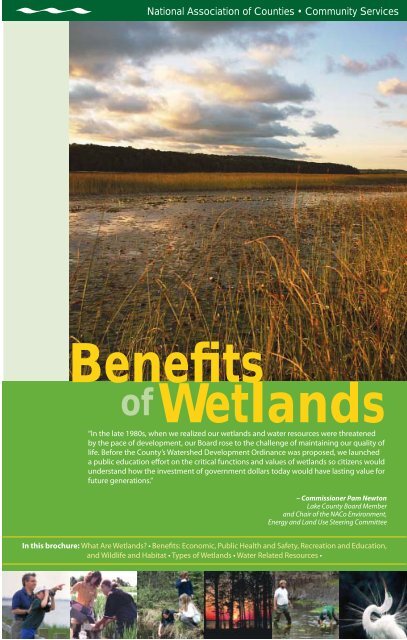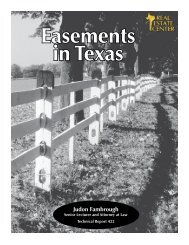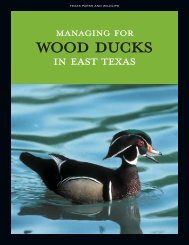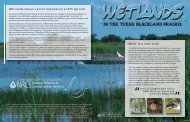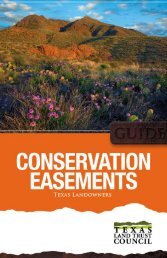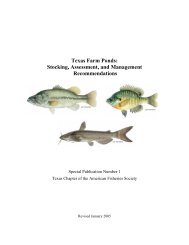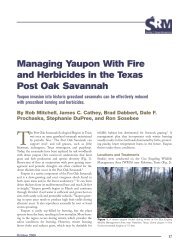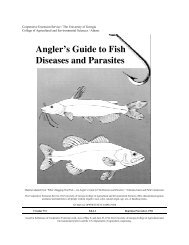Benefits of Wetlands - Trinity Waters
Benefits of Wetlands - Trinity Waters
Benefits of Wetlands - Trinity Waters
- No tags were found...
You also want an ePaper? Increase the reach of your titles
YUMPU automatically turns print PDFs into web optimized ePapers that Google loves.
National Association <strong>of</strong> Counties • Community Services<strong>Benefits</strong><strong>of</strong><strong>Wetlands</strong>“In the late 1980s, when we realized our wetlands and water resources were threatenedby the pace <strong>of</strong> development, our Board rose to the challenge <strong>of</strong> maintaining our quality <strong>of</strong>life. Before the County’s <strong>Waters</strong>hed Development Ordinance was proposed, we launcheda public education effort on the critical functions and values <strong>of</strong> wetlands so citizens wouldunderstand how the investment <strong>of</strong> government dollars today would have lasting value forfuture generations.”– Commissioner Pam NewtonLake County Board Memberand Chair <strong>of</strong> the NACo Environment,Energy and Land Use Steering CommitteeIn this brochure: What Are <strong>Wetlands</strong>? • <strong>Benefits</strong>: Economic, Public Health and Safety, Recreation and Education,and Wildlife and Habitat • Types <strong>of</strong> <strong>Wetlands</strong> • Water Related Resources •
etlands ... the link between land and waterWhat Are <strong>Wetlands</strong>?A wetland – whether it is called a swamp, marsh,fen or bottomland hardwood - is a unique placeserving as the link between land and water.<strong>Wetlands</strong> provide a wide range <strong>of</strong> ecological,economic, public safety and social benefits to communities.They produce harvestable products andprovide recreation and education opportunities. Inaddition, wetlands are habitat for wildlife, birds andfish. They create a distinctive ecosystem where theflow <strong>of</strong> water, the cycling <strong>of</strong> nutrients and the energy<strong>of</strong> the sun join together and perform a vital role ina watershed. Using a watershed-based approach towetland protection ensures that the whole system,including land, air and water resources, is protected.<strong>Waters</strong>hed-BasedApproachA watershed is defined by the EPA as the area inwhich all water, sediments, and dissolved materialsflow or drain from the land into a common river, lake,ocean, or other body <strong>of</strong> water. A watershed maycontain multiple types <strong>of</strong> wetlands as illustratedin this brochure. Programs protecting the habitat,flood control, recreational and education benefits<strong>of</strong> a wetland can be incorporated into an overallwatershed plan that benefits an entire ecosystem.The watershed-based approach addresses strainsto the land, air, and water, and is a collaborativeplanning process that brings together citizens,non-pr<strong>of</strong>it organizations, businesses, and local,state, tribal and federal governments. Today, ascounties endeavor to balance the demands growingpopulations place on land and water resourceswith economic development needs, planning iscritical. A comprehensive county watershed planallows a county to establish visions and goals for thearea, identify and evaluate their local wetlands andconsider alternative impacts on a wetland area priorto development or the implementation <strong>of</strong> changes.For more information on watershed planningvisit the Center for <strong>Waters</strong>hed Protection atwww.cwp.org.Economic <strong>Benefits</strong>The natural functions <strong>of</strong> wetlands provide economicvalue to communities. <strong>Wetlands</strong> provide foodand nursery areas for commercial and recreationalspecies <strong>of</strong> fish and shellfish. <strong>Wetlands</strong> also providegoods and services such as water filtration, habitat,flood control and food production. We even getcranberries, blueberries, mint, wild rice and manymedicines from wetlands.Although the tangible benefits <strong>of</strong> wetlands – suchas the cranberries and medicines mentioned above– are easier to calculate in terms <strong>of</strong> a dollar value,the true economic value <strong>of</strong> wetlands is difficult todetermine due to the uniqueness and variety <strong>of</strong> theirfunctions. However, an estimated value <strong>of</strong> all economicbenefits generated by a single acre <strong>of</strong> wetlandis between $150,000 and $200,000. The flood controlfunctions that wetlands provide can also preventcostly expenditures in erosion control projects likeriparian and stream bank stabilization.Did you know?A study assessing theworld’s natural ecosystemsestimated that theglobal value <strong>of</strong> wetlandresources was $14.9 trillion,accounting for 45%<strong>of</strong> the value <strong>of</strong> all naturalecosystems.Early identification<strong>of</strong> wetlands in thelandscape increasesopportunities tomaintain the functionsand values theyprovide. Residentialand commercial developmentsmay beable to increase thevalue <strong>of</strong> their propertyand reduce negative environmental impacts byincorporating habitat areas and stormwater controlinto site designs. According to the EPA, maintainingnatural wetlands in residential areas can increasereal property values by up to 28 percent while alsoenhancing the quality <strong>of</strong> life.County Spotlight -Lake County, IllinoisLake County is a large urban county situated innortheastern Illinois, with Lake Michigan to the east,Wisconsin to the north and the City <strong>of</strong> Chicago to thesouth. It comprises 448 square miles and in 2000 thisrapidly growing coastal county’s population was justunder 650,000 people.2
County Spotlight –Pima County, ArizonaPima County is a growing county and is currently thesecond largest <strong>of</strong> the four original Arizona counties. Accountingfor 9,187 square miles <strong>of</strong> southern Arizona, thecounty includes the city <strong>of</strong> Tucson and is a large urbancounty with a population in 2000 <strong>of</strong> over 840,000 people.Pima County is protecting endangered species andhabitats through the Sonoran Desert Conservation Plan.The Sonoran Desert is rich in biodiversity and one <strong>of</strong> thetop eco-regions in the world. Pima County is committedto the long-term survival <strong>of</strong> native plants and animals andthe conservation <strong>of</strong> its cultural resources, and now has asingle plan comprised <strong>of</strong> natural resource protection andland use planning activities. The county’s conservationplan places priority on preserving and protecting thesenatural resources while also being mindful <strong>of</strong> growth inthe area.Pima County recognizes that 60 to 75% <strong>of</strong> all speciesin the state <strong>of</strong> Arizona depend on a riverine area orwetland at some point in their life cycle. So the county’splan includes guidelines on the conservation <strong>of</strong> 95% <strong>of</strong>the wetland areas that will be affected by developmentthrough conservation easements, restoration projects,zoning revisions, and partnerships with public and privateentities. To learn more about Pima County’s role in the SonoranDesert Conservation plan visit: www.co.pima.az.us/cmo/sdcp/index.html.Wetland and <strong>Waters</strong>hed-Related Resourcesfor Local Governments● National Association <strong>of</strong> Counties (NACo) – providescounty <strong>of</strong>ficials with wetlands and watershed technicaland legislative assistance as well as funding through theFive Star Restoration Challenge Grant Program. NACo is apartner in this EPA funded program that supports community-basedwetlands restoration projects. www.naco.org/techassistance under Water Quality or contact Erik Johnstonat (202) 942-4246 or ejohnston@naco.org.● U.S. Environmental Protection Agency (EPA), <strong>Wetlands</strong>Division – provides comprehensive informationon laws and regulations, benefits <strong>of</strong> preserving wetlands,financial assistance and regional resources. www.epa.gov/owow/wetlands– For a wide range <strong>of</strong> wetlands fact sheets go towww.epa.gov/owow/wetlands/facts/contents.html.– View the wetlands publications list at www.epa.gov/owow/wetlands/wetpubs.html.– The EPA <strong>Wetlands</strong> Information Hotline 1-800-832-7828 isavailable Monday through Friday 8:30 am to 5:30pm ESTto provide specific information on wetlands regulation,legislation and policy, or to order resources.● Association <strong>of</strong> State Floodplain Managers – Thegoal <strong>of</strong> this association is to mitigate the losses, costs andhuman suffering caused by flooding and to promote wiseuse <strong>of</strong> the natural and beneficial functions <strong>of</strong> floodplainsthrough policy and practice changes. www.floods.org/home/default.asp● Association <strong>of</strong> State Wetland Managers – Providespamphlets, books, brochures, white papers and summaries<strong>of</strong> findings <strong>of</strong> symposia and workshops as well asinformation on local, state and federal wetlands programs.www.aswm.org● Center for <strong>Waters</strong>hed Protection – Provides education,outreach and training on watershed protection, planning,restoration and research as well stormwater managementand better site design. www.cwp.org● National Marine Fisheries Service RestorationCenter (National Oceanic and Atmospheric Administration)– Focuses on enhancing living marine resources tobenefit the nation’s fisheries by restoring degraded habitats,advancing the science <strong>of</strong> coastal habitat restoration, transferringrestoration technology and fostering habitat stewardshipand a conservation ethic. www.nmfs.noaa.gov/habitat/restoration/● National <strong>Wetlands</strong> Inventory Center (U.S. Fish andWildlife Service) – Provides digitized wetland maps, statusand trend reports as well as manuals, plant and hydric soilslists, field guides, posters, wall size resource maps, atlases,state reports and numerous articles published in pr<strong>of</strong>essionaljournals. www.nwi.fws.gov● National <strong>Wetlands</strong> Research Center – Is a part <strong>of</strong>the Biological Resources Division <strong>of</strong> the U.S. GeologicalSurvey and serves as a source and clearinghouse <strong>of</strong> scienceinformation about wetlands in the United States and world.www.nwrc.usgs.gov● Stormwater Manager’s Resource Center – Provideslinks to stormwater management information including:manuals, ordinances, articles, fact sheets and a library <strong>of</strong>slideshows. www.stormwatercenter.net6
● U.S. Army Corps <strong>of</strong> Engineers – provides resources andlinks to information about wetlands regulation and permitting.www.usace.army.mil/missions/environment.html● Water Environment Federation – Provides researchpublications, training and technical expertise on wastewatertreatment and water quality protection. www.wef.org● <strong>Wetlands</strong> Mapper – Provides wetlands mapdata applications and easy-to-use, maplike views <strong>of</strong>America’s wetland resources in a digital format. http://wetlandsfws.er.usgs.gov● <strong>Wetlands</strong> Regulation Center – Provides informationon laws, policies and regulations concerning activitiesregulated under Sections 401 and 404 <strong>of</strong> the Clean WaterAct. www.wetlands.com● Wetland Reserve Program – A U.S. Department <strong>of</strong>Agriculture program that <strong>of</strong>fers landowners technical andfinancial support to protect, restore and enhance wetlands.www.nrcs.usda.gov/programs/wrpThe EPA <strong>Wetlands</strong> Information Hotline: 1-800-832-7828Available Monday through Friday 8:30 am to 5:30pm EST to provide specific information on wetlands regulation, legislationor EPA regional and national wetlands contacts.AcknowlegementsNACo thanks the following individuals and organizations for contributingto this brochure:• the U.S. Environmental Protection Agency, Office <strong>of</strong> <strong>Wetlands</strong>, Oceansand <strong>Waters</strong>heds provided funding through Cooperative AgreementsX7 - 83115601 and CD-83266201.• Photos courtesy <strong>of</strong>: submissions to the EPA Wetland Photo Contest includingDennis Demcheck, Mathew Poach, Matt Giannti, Elinor Osborn,Barbara Keywood, Corey Michael, James McIntyre, Mark Dilley, MistieJordan, Gary Armstrong, Arthur Popp, Jim Newton, and Jay O’Brien;Takemefishing.org; and Texas Parks and Wildlife Department.• Research and writing by NACo staff: Erik Johnston, Kelly Zonderwykand Kristen Bertram; and editing by Abigail Friedman.• Graphic design and layout by Jack Hernandez <strong>of</strong> NACo• County staff and <strong>of</strong>ficials who provided information.• Disclaimer: The opinions in this publication are those <strong>of</strong> the contributors,and do not necessarily reflect the views <strong>of</strong> the EPA or NACo.ReferencesApfelbaum, S.I., M. Sands, T.H. Price, J.D. Eppich. 1995. The Prairie CrossingProject; Attaining Water Quality and Stormwater Management Goalsin a Conservation Development. In Proceedings <strong>of</strong> National Symposiumon Using Ecological Restoration to Meet Clean Water Act Goals. Chicago,Ill. March 14-16, US EPA Conference.Costanza, R., D’Arge, R,, and R.D. Groot. 1997. The value <strong>of</strong> the world’secosystem services and natural capital. Nature (London), 387:253-260.The Trust for Public Land, Economic <strong>Benefits</strong> Report (1999)www.tpl.org/tier3_cdl.cfm?content_item_id=1159&folder_id=727.The U.S. Environmental Protection Agency (EPA), Economic <strong>Benefits</strong> <strong>of</strong>Run<strong>of</strong>f Controls (Sept. 1995) www.epa.gov/OWOW/NPS/run<strong>of</strong>f.html.The U.S. Environmental Protection Agency (EPA), Functions and Values<strong>of</strong> <strong>Wetlands</strong> Fact Sheet (Sept. 2001) www.epa.gov/owow/wetlands/facts/fun_val.pdf.The U.S. Environmental Protection Agency (EPA), <strong>Wetlands</strong> and <strong>Waters</strong>hedsFact Sheet www.epa.gov/owow/wetlands/facts/fact26.html.The U.S. Environmental Protection Agency (EPA), <strong>Wetlands</strong> Functionsand Values Module (Oct. 2002) www.epa.gov/watertrain/wetlands.7
440 First Street NWWashington DC 20001(202) 393-6226Fax: (202) 393-2630www. naco.org8


